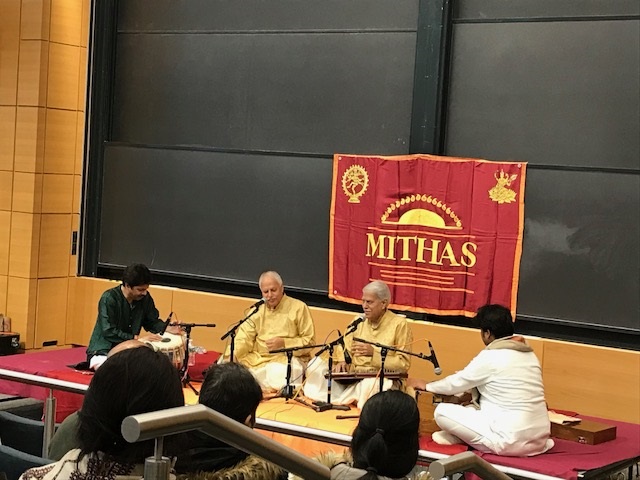Contribute
| Brilliant Hindustani Jugalbandi By Pandits Rajan And Sajan Mishra |
Shuchita Rao
04/19/2018
It was as if Banaras’s warmth had enveloped icy-cold Boston on the weekend of April 14, 2018 when the renowned vocalist duo Padmabhushan Rajan Sajan Mishra from the Banaras Gharana performed on consecutive days for the local non-profit music organizations, Shadaj and MITHAS (MIT Heritage Arts of Southasia). Dr. George Ruckert, one of the MITHAS founding members, welcomed a diverse audience in the packed Wong auditorium on Sunday afternoon, April 15, with the words “ We have two giants performing for us today. This the 13th concert of a 50 city “Bhairav Se Bhairavi tak†tour across four continents. It is an auspicious day for MITHAS.â€
The “Bhairav Se Bhairavi tak†tour conceived by New Delhi resident Saloni Gandhi, began in November 2017 in Banaras, India. The music team comprising of vocalists Pandits Rajan Sajan Mishra, harmonium artist Sumit Mishra, tabla artist Shantilal Shah and producer Saloni Gandhi has traveled across countries of South East Asia including China, Vietnam, Thailand and Cambodia, Canada in the last six months and is now on a 15 city tour across the US. Later in the year, the team will perform in the continents of UK, Australia and South Africa.
“Music is our worship, our ibaadat, our pooja and we invite you to join us in our worship this afternoon†said Pandit Rajan Mishra before beginning a detailed exploration of the afternoon raga Multani. “Gokul Dham†in 12 beat cycle Ektaal was rendered in a slow tempo replete with imaginative bol-alaaps, aakaar alaaps, sargams, sustained rests at Nishad and Shadaj and systematic development of the raga across three octaves. The richness of the presentation came from the sonority of voices and intonation of notes, mature imagination, effortless span across three octaves and modulated varied speed taans (fast melodic passages). The next composition was in sixteen beat cycle known as addha theka and it included brief but attractive solos of harmonium as well as tabla instruments. “Bagiya may tamaashay ho, Nahi aaya dilbar mera†was full of the “viraha†(separation and grief) emotion. The traditional composition in twelve beat cycle ektaal “Aangan may nandlal†had fast taans that arrived on the first beat of the rhythm cycle, the “sum†, with unfailing accuracy and flourish.
After an hour of presenting raga Multani, the artists went on to present shorter duration compositions in three ragas, Hanskinkini, Dhani and Kamod. “Deep Jalaao Madan Mohan Ghur Aaye†set to medium tempo ten beat cycle Jhaptaal in Raga Hanskinkini featured the signature phrase “ga(komal or flat) Re Sa, Re Ni Sa Re Ga(Shuddha or Regular)†establishing the character and personality of the Kaafi family raga. A Khayal-numa taraana in fast paced teentaal that was rendered next, impressed the audience with its pleasing layakaari.
For the second short raga presentation, the artists sang a composition “Mandalara Baajo Re†set to sixteen beat cycle teentaal in raga “Dhani†with antara words “Sub Sakhiyaan mil nacho gaavo, dhoom machaao, piya ko rijhaao†bringing vivid images of young women singing and dancing in gaiety. An occasional, deft touch of shuddh rishabh in the descent made the rendition unique.
Pandit Rajan Sajan Mishra did full justice to the next raga, Kamod which was a suggestion from the audience. A khayal in fourteen beat cycle Deepchandi “Balma Na Maane†was a treat because khyal compositions set to deepchandi taal are a rarity. Two faster tempo compositions, “Ritu Basant Mo Mana Bhavata†and “Kaare Jaane Na Doongi†(A Mohammed Shah Rangile composition that was adapted by music composer Madan Mohan for the film Chitralekha with the words “Ae ri jaane na doongiâ€) in sixteen beat cycle teentaal brought great joy to the audience.
The two and half hour performance without intermission came to an end with an evocative Tulisdas bhajan “Janani Main Na Jiyoon Bin Ram†rendered with heart-touching emotion. The song told the story of Lord Ram’s younger brother Bharat returning to the kingdom of Ayodhya to find that his two brothers Ram, Lakshman and sister-in-law Seetha had departed to the forest to live like hermits while their father Dashrath had passed away in grief due to their departure.
The strengths of the jugalbandi performance lay in immaculate delivery of the compositions, accurate portrayal of chosen ragas, vivid imagination in the alaap section of the raga development, modulated, varied tempo taans, admirable physical stamina as well as the intimate rapport the artists built with the audience. To show the power of a “jugalbandi†which is a performance by two artists of similar caliber, Pandit Rajan Sajan Mishra used among several techniques, alternate singing of sargam and aakaar taan patterns and extending each other’s musical ideas in a complimentary manner with uncanny expertise that has evolved from singing together over five decades. The mutual respect among the brothers has been a great factor in their success as a performing duo of the highest standing.
This Pandit Rajan Sajan Mishra concert, one among the series of Hindustani and Carnatic concerts marking the 25th year of MITHAS’s existence and contribution to the arts and culture of Boston, will be remembered for a long time to come by Boston’s music loving community. The next two concerts are a Carnatic violin concert on Saturday, May 12 7pm by Ganesh-Kumaresh and a Hindustani Vocal recital by Sangeet Martand Pandit Jasraj on Saturday, May 19 at 7pm. To purchase tickets for the Pandit Jasraj concert, visit http://www.mithas.org/Events/S18_Jasraj_EventInfo.html.
You may also access this article through our web-site http://www.lokvani.com/
